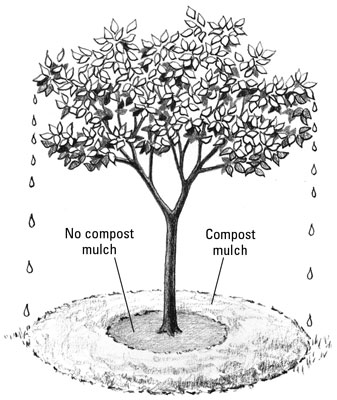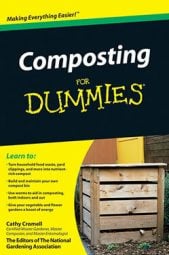Compost, whether you buy it or make it yourself makes tremendous mulch. Organic mulch, such as that derived from compost, has all the usual benefits in addition to supplying nutrients to the soil as it decomposes. On beds of permanent plants, trees, hedges, and fruit, an annual mulch of compost will keep your soil in good health and your plants in top condition.
Here are a few more advantages of compost mulch:
Compost's rich, dark color and crumbly uniform texture adds an attractive, "finished" look to planting areas.
Compost mulch breaks down faster than bark chips or shredded wood chips, releasing its nutrients more quickly for plants to absorb. Keep in mind that because compost mulch breaks down faster, it needs to be reapplied more frequently than wood-chip mulch, perhaps yearly.
Compost mulch doesn't harbor artillery fungi (Sphaerobolus stellatus) or other nuisance fungi found in some regional wood-chip mulches. Reproduction efforts of these so-called "shotgun" fungi involve shooting messy black or brown spores through the air, which are difficult to clean off buildings, cars, and patio surfaces.
Birds and other wildlife are delighted by compost-rich beds that are also rich in worms and other creatures on which to feast.
Spread your compost mulch around the base of a plant outward to the canopy edge, always keeping it away from the stem or trunk because wet mulch in contact with plant tissue creates a hospitable environment for disease and pest problems. Keep pace with expanding canopies by adding more compost mulch as plants grow.
How thick a layer of compost mulch you need to apply varies, depending on climate and soil conditions. If you're an arid-land gardener, apply 2 to 4 inches (5 to 10 centimeters) around plants. If you garden in cool climes, 2 to 3 inches (5 to 8 centimeters) is sufficient.

Although it was once standard practice to amend a tree or shrub's planting hole backfill with compost or other organic matter, this is no longer recommended. For a landscape plant to develop, its roots must spread outward into native surrounding soil to access water and nutrients and to develop a strong anchor. Researchers discovered that roots tend to stay cozily ensconced within amended planting holes. The plants effectively become rootbound, as if they were still confined to their nursery pot. However, if you are filling a border with mixed plants, dig and enrich the entire bed with compost before planting.

